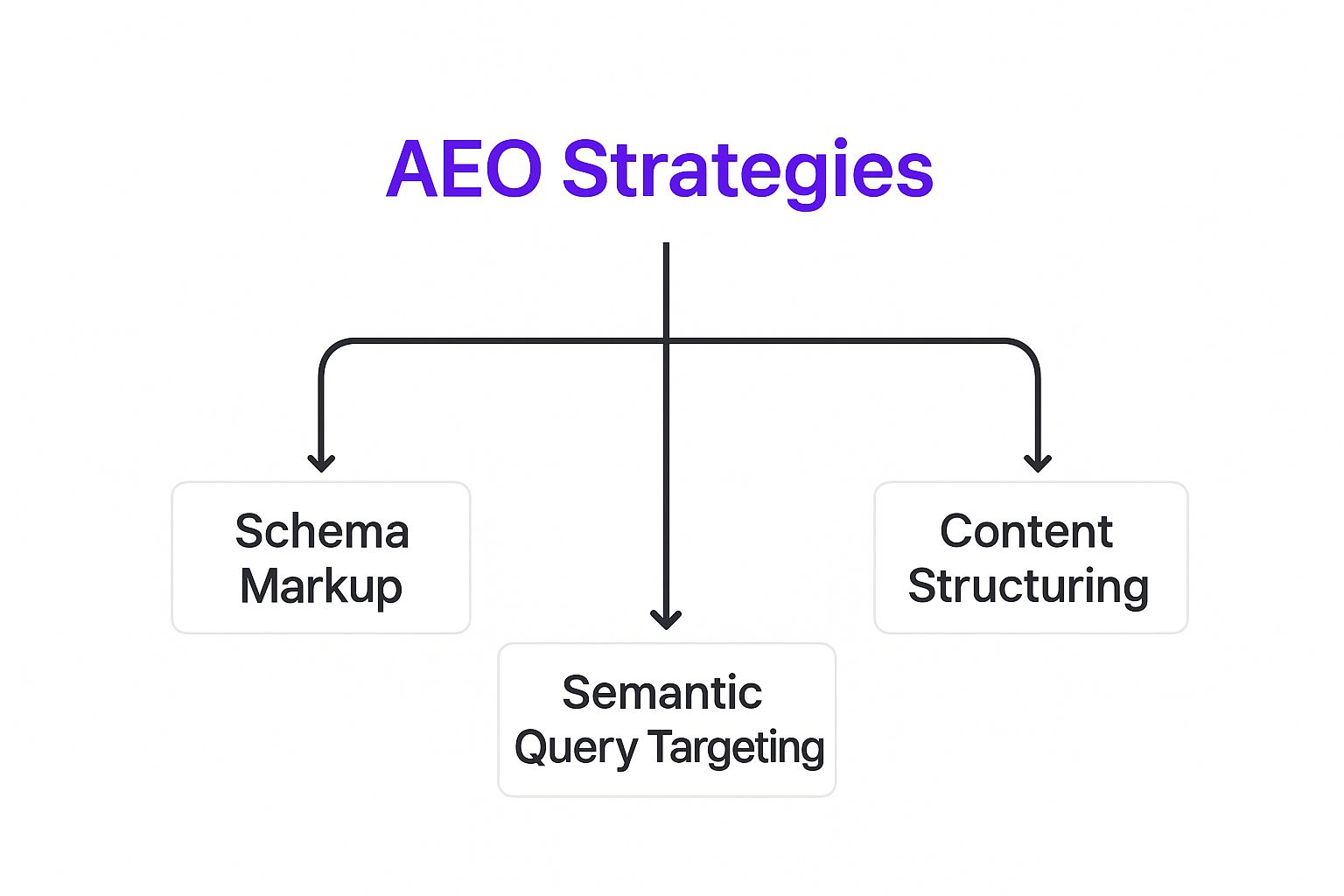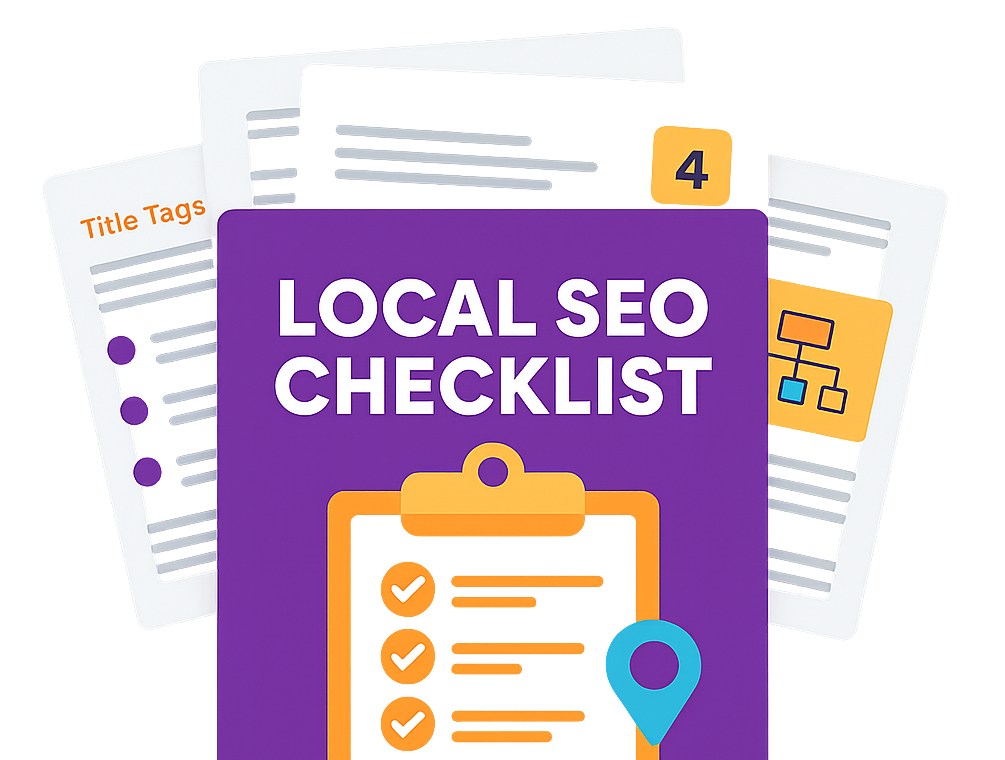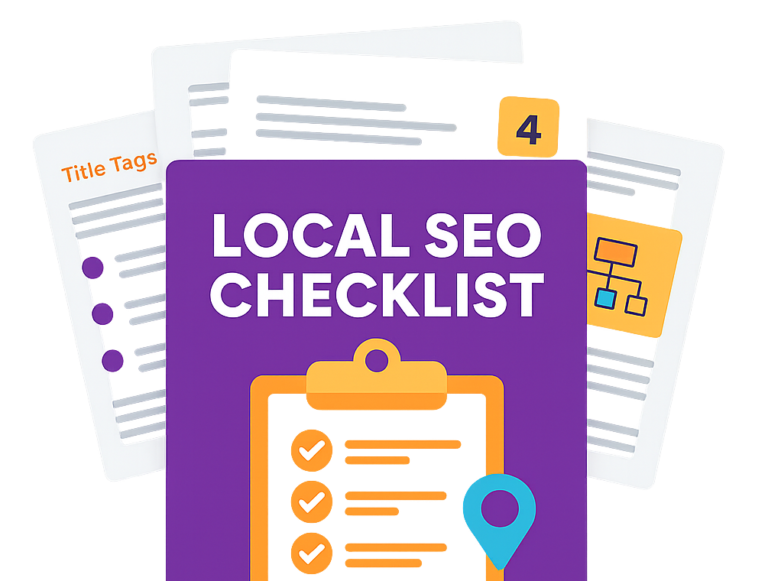Answer Engine Optimisation (or AEO) is all about creating web content that directly answers a user's question right there on the search engine results page. It’s a modern take on SEO that focuses on securing those prime spots like AI Overviews, featured snippets, and voice search results.
This approach moves beyond just ranking for keywords; it’s about positioning your brand as the go-to authority.
The Evolution from Search to Answers

For years, Search Engine Optimisation (SEO) was a fairly simple game. The goal was to get your website onto a list of search results. Think of it like a librarian pointing you to a shelf of relevant books; you still had the job of sifting through them to find your answer.
But today, search engines like Google act more like answer engines. Now, that same librarian doesn't just point you to the shelf—they open the right book and read you the exact paragraph you need. This is the heart of Answer Engine Optimisation (AEO). It's about becoming that definitive paragraph.
Why This Shift Matters for Your Business
This isn’t just a small tweak; it’s a fundamental change driven by AI and our demand for instant information. People no longer just type in a few keywords. They ask full questions, especially with the explosion of voice assistants like Siri and Alexa.
And here’s the thing: these devices don't read out a list of ten blue links. They give you one clear, authoritative answer.
The same principle applies to Google's AI Overviews and featured snippets—those handy boxes at the top of the page that give you an instant summary. When you secure one of those spots, your business becomes the trusted source, gaining massive visibility even if the user never clicks through to your site. For UK businesses, embracing AEO isn't just a trend; it's a vital part of any modern digital strategy.
Key Takeaway: The goal of Answer Engine Optimisation is no longer just to rank high but to be the answer. It’s about providing direct, accurate information that search engines can easily grab and present to users.
To really get to grips with AEO, it helps to see how it stacks up against the SEO methods we've used for years.
| Focus Area | Traditional SEO Approach | Answer Engine Optimisation (AEO) Approach |
|---|---|---|
| Primary Goal | Rank a webpage in the top 10 results. | Become the direct answer in snippets, voice, and AI results. |
| Keyword Strategy | Focus on broad and long-tail keywords. | Focus on conversational questions and user intent. |
| Content Focus | Create comprehensive articles around a topic. | Create concise, structured content that directly answers a query. |
| Key Metric | Organic traffic and keyword rankings. | Visibility in "Position Zero" and voice search mentions. |
| Technical Focus | On-page elements, site speed, and backlinks. | Structured data (Schema), FAQs, and clear formatting. |
This table shows a clear pivot. While the foundations of good SEO are still important, AEO demands a more focused, answer-centric strategy that aligns perfectly with how modern search engines operate.
The Impact on UK Businesses
The proof is in the pudding. In the United Kingdom, SEO has matured significantly. Data from early this year revealed that over 90% of UK businesses with active SEO strategies find them effective. This success is increasingly tied to optimising content to serve direct answers.
As search evolves, understanding how these new methods differ from the old ones is crucial. You can get a great breakdown by comparing Generative Engine Optimization vs. SEO. This shift away from legacy tactics like keyword stuffing and basic backlinking has forced businesses to rethink their entire online presence.
Success is no longer measured just in clicks and traffic. It’s about authority and trust. By mastering answer engine optimisation, your business can:
- Gain "Position Zero" Visibility: Jump to the very top by appearing in featured snippets, "People Also Ask" boxes, and AI summaries, putting you above the traditional number one spot.
- Become a Voice Search Staple: Get chosen as the default answer for voice assistants, connecting your brand directly with customers in their homes and on the move.
- Build Unshakeable Authority: When Google repeatedly uses your content to answer questions, it sends a powerful signal to both users and its algorithm that you're a credible expert in your field.
The Real-World Impact of Zero-Click and Voice Searches

The big push towards Answer Engine Optimisation isn’t just some new industry fad. It’s a direct reaction to two huge shifts in how we all use search engines every day. The first, and arguably most important, is the rise of the zero-click search.
You’ve definitely experienced this yourself. You type a question into Google, and the answer appears right there at the top of the page in a featured snippet, a knowledge panel, or an AI-powered summary. You get what you need instantly, so you never actually click through to a website.
For a lot of businesses, this sounds like bad news. Fewer clicks must mean less traffic, right? Not necessarily. It’s a massive opportunity to build your brand’s authority and visibility. When your company’s name and content are repeatedly served up as the definitive answer, you build incredible trust—often before a user even visits your site.
The Voice Search Revolution
The second major force is the explosion of voice technology. Millions of us in the UK now chat with Alexa, Siri, and Google Assistant on a daily basis. Think about how you use them: you ask a direct question and expect a single, spoken answer back.
This is AEO in its purest form. Voice assistants are built to deliver one correct response, not a list of ten blue links. They pull their information from the same well-structured, answer-focused content that fuels those featured snippets on Google. If your content isn't optimised to provide that one concise answer, you're completely invisible in the world of voice search.
Voice search and zero-click searches are two sides of the same coin. Both are driven by our demand for immediate, accurate information. They rely on search engines being able to find and extract a single, trustworthy answer from the web.
Success is no longer just about chasing clicks. It's about becoming the trusted source that powers these direct answers, cementing your brand as the go-to expert in your field. This shift is a critical one for businesses, and many current SEO trends are being shaped by this move towards instant information.
What This Means for UK Businesses
The growth of zero-click and voice searches has completely changed the game for businesses in the UK. Because people can get answers instantly on the results page, the old goal of simply ranking highly isn't enough anymore. UK businesses have to adapt, prioritising strategies that make them the answer, not just another option on the list.
For a small or medium-sized business, this shift is a massive opportunity. You might not have the marketing budget of a corporate giant, but you can win by focusing on what truly matters: expertise and clarity.
Here’s how this new reality should shape your strategy:
- Your Content Must Be Instantly Useful: Your content needs to answer questions directly and without waffle. The 'inverted pyramid' writing style, where you lead with the conclusion, is more important than ever. Get to the point, fast.
- Authority is More Valuable Than Clicks: Being the source for a featured snippet builds brand recognition and establishes you as a leader. This pays off later with more valuable, high-intent traffic from users who already trust you.
- Local Queries are King: A huge number of voice and mobile searches have local intent (think "plumbers near me" or "best coffee in Manchester"). Keeping your Google Business Profile optimised and creating local content is non-negotiable for capturing these answer-driven searches.
The Core Pillars of a Winning AEO Strategy
Moving from theory to practice means getting to grips with the foundations of any solid answer engine optimisation strategy. A winning AEO approach isn't about chasing one specific tactic; it's about building a solid structure from three key pillars. These components work together, sending powerful signals to search engines that your content is the most direct and trustworthy answer to a user's question.
The first pillar is creating Content for Intent. This is a fundamental shift in mindset. Instead of asking, "what keywords do we want to rank for?", you need to ask, "what questions do our customers really need answers to?". It’s all about getting inside the user’s head and creating content that gives them a direct, satisfying answer without any fluff.
Your goal is to become the go-to resource for that specific query. When someone asks a question, your content should feel like it was written just for them, tackling their problem head-on.
Sending the Right Technical Signals
The second pillar is Technical Signalling, which is mostly about using structured data, or what we call Schema markup. Think of Schema as a universal translator for search engines. Your webpage might clearly say you're hosting an event, but without Schema, the search engine's AI is left guessing about the specifics.
By adding Schema markup, you’re explicitly telling the AI: "This is the event name, this is the date, this is the location, and here’s the ticket price." It removes all the guesswork.
This diagram shows how Schema markup, content structure, and targeting user queries form the very core of effective AEO.

As you can see, these three elements are completely interconnected. Each one reinforces the others to create a powerful AEO framework that actually works.
For a UK-based SME, getting this right can be the difference between a user seeing a standard blue link and an engaging rich snippet packed with review stars, opening hours, or event details. These little extras make a huge difference to click-through rates. Developing a strong AEO strategy often involves using AI for knowledge management to make sure your data is accurate and ready for answer engines to use.
Demonstrating Your E-E-A-T
The third and final pillar is E-E-A-T, which stands for Experience, Expertise, Authoritativeness, and Trustworthiness. This is Google's framework for judging content quality, and it's absolutely essential for answer engine optimisation. Search engines want to serve up answers from sources they can trust without a second thought.
You demonstrate E-E-A-T by showing the real-world credentials behind your content.
E-E-A-T isn't just a guideline; it's the currency of trust online. To become the answer, you must first prove you are a credible source worthy of providing it.
Here’s how UK businesses can put this pillar into practice:
- Experience: Show that the author has first-hand experience. A guide on fixing a boiler should be written by a certified heating engineer, and you should make that crystal clear.
- Expertise: Display your credentials, qualifications, and any awards. An accountant writing about tax advice needs to have their professional certifications clearly visible.
- Authoritativeness: Build your reputation in your industry. This means getting cited by other respected sources, publishing case studies, and joining in with industry conversations.
- Trustworthiness: Be transparent. Provide clear contact information, have a secure website (HTTPS), and show off genuine customer reviews and testimonials.
By combining direct, intent-driven content with clear technical signals and undeniable proof of your credibility, you build a powerful AEO strategy. To see how this fits into the bigger picture, exploring the role of AI for SEO provides some valuable context. This complete approach ensures you're not just visible, but you’re seen as the definitive answer.
How to Put AEO Into Practice
Knowing what Answer Engine Optimisation is is one thing; actually putting it into practice is another. For UK businesses, turning theory into real-world results means taking a practical, step-by-step approach. It’s about demystifying the tech talk and focusing on what really matters: giving your customers the clear answers they’re searching for.
Before you even think about content, make sure your foundations are solid. Things like selecting an SEO-friendly domain name can make a surprising difference to your long-term brand recognition and visibility. Get the basics right, and you'll have a much stronger platform to build on.
Start with Question-Based Research
Your first move? Stop thinking about keywords in the traditional sense. Instead, get inside your customer's head and figure out the exact questions they're asking. What problems are they wrestling with? What do they need to know before they feel comfortable making a decision?
Finding these questions isn't as hard as it sounds. You just need to know where to look:
- Google's "People Also Ask" Boxes: This is a goldmine. For any search term, Google will literally hand you a list of related questions.
- Online Forums: Dive into places like Reddit and Quora. You'll find raw, unfiltered conversations about your industry and the real problems people face.
- Your Own Customer Service Team: Your sales and support staff are on the front line. The questions they answer day-in, day-out are often the most valuable ones to target.
Once you have your list, you can start building content that answers these questions head-on.
Structure Content Like a Journalist
Ever heard of the ‘inverted pyramid’? It’s a classic journalism technique, and it’s perfect for AEO. The idea is simple: put the most important information—the direct answer—right at the very top. The rest of the article is then used to add supporting details and context.
Start your page with a short, sharp answer to the main question. Then, you can use the rest of the space to elaborate and go into more detail.
AEO Content Structure:
- The Direct Answer: Kick things off with a one or two-sentence summary that directly answers the user’s question.
- Supporting Details: Back up your answer with key points, steps, or a bit more explanation.
- Deeper Context: Finish by offering background information, helpful examples, or related insights.
This structure makes it incredibly easy for Google's AI to find your answer and pull it into a featured snippet or use it for a voice search response.
Implement Essential Schema Markup
Schema markup is that 'translator' we talked about earlier. It's a bit of code you add to your website that gives search engines crystal-clear context about what your content is. It might sound a bit technical, but it's an absolutely crucial part of any modern AEO strategy.
By using these clear labels, you're leaving nothing to chance. For a UK business, there are three types that are especially important:
- FAQPage Schema: Ideal for pages where you're answering a bunch of related questions.
- Article Schema: This helps Google understand your blog posts, signalling important info like who wrote it and when it was published.
- LocalBusiness Schema: A must-have for any brick-and-mortar business. It lets you specify your opening hours, address, and services for local searches.
Getting structured data and schema markup right is reported as essential for helping AI understand your content, which in turn boosts your chances of landing in featured snippets and voice search answers.
Optimise Your Google Business Profile
If your UK business has any kind of local footprint, your Google Business Profile (GBP) is probably your most powerful AEO tool for local searches. A huge number of queries have local intent—think "best fish and chips near me" or "solicitors in Cambridge".
A well-maintained GBP feeds information directly into Google's answer engine, powering the map packs and local knowledge panels that people rely on.
Key GBP Optimisations:
- Make sure your Name, Address, and Phone Number (NAP) are identical everywhere they appear online. Consistency is key.
- Use the Q&A feature to proactively ask and answer the common questions you get about your business.
- Keep your profile fresh by regularly adding posts, photos, and updates. This shows Google you’re active and relevant.
While these steps take a bit of work, they create a clear roadmap for any small business looking to get started with AEO. If you’re handling this process in-house, our guide on how to do SEO yourself offers more foundational knowledge to support your efforts.
Measuring the Success of Your AEO Efforts

So, you’ve put in the work to optimise for answer engines. But how do you know if it's actually paying off?
Implementing an Answer Engine Optimisation strategy means you have to think about performance differently. When your content lands in a featured snippet or an AI Overview, the user often gets what they need without ever clicking through to your site. This is great for them, but it can make traditional metrics feel a bit… misleading.
Success with AEO isn't just about traffic. It's a mix of visibility, authority, and the quality of the engagement you do manage to get. You need to look past simple click-through rates and start measuring your influence directly on the search results page.
This is a crucial shift. You’re not just chasing clicks anymore; you're aiming to become the go-to, recognised answer in your field. It’s an approach that builds brand equity, and that pays off massively in the long run.
Tracking Position Zero Visibility
The most direct way to measure your answer engine optimisation success is to see how often you’re showing up in "position zero". This is prime real estate—any result that appears above the traditional number one spot, like featured snippets, knowledge panels, and the "People Also Ask" boxes.
You can use standard SEO tools like Semrush or Ahrefs to track which of your target keywords are triggering these features and, most importantly, whether your website is the one being featured. An increase in the number of snippets you own is a crystal-clear sign your AEO work is hitting the mark.
By appearing in position zero, your brand achieves a level of visibility and perceived authority that traditional rankings can't match. You are, in Google's eyes, the most credible source for that particular query.
Grabbing this spot shows your content is well-structured, authoritative, and perfectly aligned with what a user is asking. It’s one of the most powerful indicators of AEO performance.
Monitoring Authority and Brand Growth
A great AEO strategy does more than just win you snippets—it quietly builds your brand's authority in the background. Two fantastic ways to measure this indirect impact are by tracking branded searches and brand mentions.
A steady increase in branded searches—people typing your company name directly into Google—is a powerful signal. When users see your name pop up time and again providing helpful answers, they start to connect your brand with expertise. Eventually, they stop searching for the answer and start searching for you.
Likewise, brand mentions across the web, even without a link back to your site, add to your authority. They show your brand is becoming part of the industry conversation.
- Branded Search Volume: An upward trend points directly to growing brand recognition and trust.
- Brand Mentions: This shows your influence is expanding beyond the walls of your own website.
Analysing Engagement and Lead Quality
While zero-click searches are part of the AEO game, the clicks you do get often become far more valuable. Think about it: if someone reads your answer in a featured snippet and still clicks through, they’re not just casually browsing. They want to go deeper.
This means the traffic you receive is often more qualified and has much higher intent.
To measure this, you need to track what these visitors do next. Are they signing up for your newsletter, downloading that guide, or filling out a contact form? If you find that traffic from these direct-answer formats is leading to more high-quality conversions, your AEO strategy is firing on all cylinders.
Getting a handle on these different performance indicators is vital. For a closer look at what to track, exploring the top metrics to measure on-page SEO success offers a solid framework that fits perfectly with your AEO analysis. Success here is multifaceted, rewarding you for visibility and authority just as much as for clicks.
Your Questions on AEO Answered
When any new idea in digital marketing comes along, it’s bound to bring a few questions with it. For UK business owners just getting to grips with answer engine optimisation, it's only natural to wonder where it fits, if it’s even possible for a smaller business, and what on earth you’re supposed to do first.
This section gets straight to the point, tackling the most common queries we hear. We'll clear up the confusion and show you how AEO can slot right into your current marketing efforts.
Does Answer Engine Optimisation Mean Traditional SEO Is Dead?
Not in the slightest. Think of AEO as the next chapter for SEO, not the final page. It’s a new, powerful layer that sits on top of all the hard work you’ve already put into your technical SEO. Things like site speed, mobile-friendliness, a sensible site structure, and good quality backlinks are still the bedrock of success. They build the foundation of trust that search engines need before they'll even consider you for a direct answer.
AEO simply adds a new dimension, focusing squarely on what the user is asking for, using structured data to speak the search engine's language, and formatting content to be understood by AI. You still need great SEO to get an invitation to the party, but AEO is what makes you the centre of attention.
Simply put, traditional SEO gets your website noticed by the search engine. Answer Engine Optimisation gets your answers noticed by the user. You absolutely need both.
Without a technically solid site that’s quick and easy to get around, even the most brilliant, answer-led content will be left in the dust. The two work together, creating a seamless experience that keeps both search algorithms and human visitors happy. This partnership is what modern digital success is all about.
Is AEO Only for Large Companies with Big Budgets?
Absolutely not. In fact, AEO can be a massive advantage for SMEs. While the big corporations throw huge budgets at dominating broad, competitive keywords, AEO allows smaller businesses to win by simply answering niche questions better than anyone else. It’s a game where expertise, not spending power, is the trump card.
A local plumber can leapfrog the national chains by focusing on a very specific, long-tail query like, 'how do I fix a dripping tap in a Victorian terraced house?' and creating the absolute best answer online. This is where your specialised knowledge—something SMEs have in bucketloads—becomes your secret weapon.
Many of the tools for implementing things like structured data are free, and creating expert content is a matter of know-how, not cash. AEO rewards clarity and expertise over a hefty marketing budget. This is where agile, smaller businesses can really outsmart their larger rivals and build a fiercely loyal customer base.
How Long Does It Take to See Results from AEO?
This is the best part—results from AEO can often show up much faster than with many traditional SEO tactics. Building up domain authority can take months, sometimes even years. But the impact of specific AEO tweaks can be surprisingly quick.
For example, correctly adding FAQ schema to a page that already ranks reasonably well could lead to rich snippets appearing in search results within a matter of days or weeks. That’s an almost instant visibility boost right there on the results page.
Of course, grabbing a featured snippet for a super competitive question will take a bit longer. The timeline depends on things like your site’s current authority, the quality of your answer, and how many other people are trying to answer the same question.
Key Factors Influencing AEO Timelines:
- Existing Authority: Sites with a solid, established reputation tend to see results faster.
- Content Quality: The clarity, accuracy, and usefulness of your answer are hugely important.
- Competition Level: You'll see quicker wins with niche questions than with those targeted by big brands.
- Technical Implementation: Getting your Schema markup right is vital for getting noticed quickly by search engines.
The key is consistency. If you keep identifying customer questions, creating top-notch answers, and applying the right technical signals, you'll build momentum. Think of it like creating a portfolio of answers—each new one you add makes your overall position even stronger.
What Is the Most Important First Step for AEO?
If you only do one thing, do this: change your mindset from ‘What keywords do I want to rank for?’ to ‘What questions do my customers need answers to?’. This is the absolute heart of AEO. It flips your entire content strategy on its head to focus on the user, which is precisely what answer engines are built to reward.
This shift in thinking is the real starting point. Get started by researching the actual questions your audience is typing into Google. Chat with your sales team, browse online forums, and use keyword tools to find the real-world problems your customers face.
Once you have a question, your mission is to create the clearest, most direct, and most helpful answer on the entire internet. Structure your content logically with the answer up top, use clear headings, and write like a human. While the technical bits like Schema are important, they're useless if your content doesn't genuinely answer the question first. Everything else flows from this one, simple, customer-focused principle.
Feeling ready to put answer engine optimisation to work for your business? At Bare Digital, we specialise in creating SEO strategies that get you seen and heard. Our bespoke services are designed to boost rankings and deliver real results for businesses across Cambridgeshire and beyond. Get in touch today for a free SEO Health Check and a tailored plan to become the go-to answer in your industry. Find out more at https://www.bare-digital.com.








